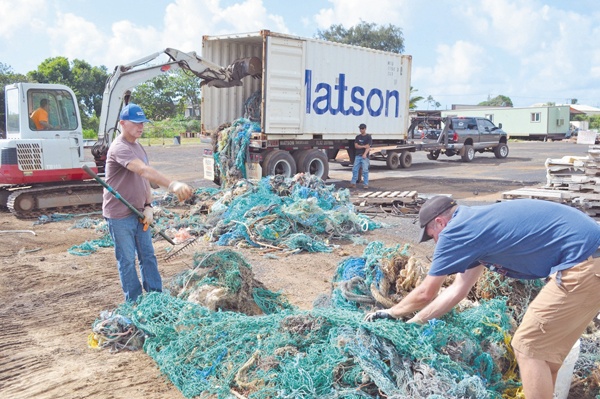LIHUE — Ghost and derelict fishing nets are the No. 1 accidental killer of marine life — not usually a topic of celebration. On Oct. 5, however, the Surfrider Foundation Kauai Chapter and Malama Na Apapa celebrated just that during
LIHUE — Ghost and derelict fishing nets are the No. 1 accidental killer of marine life — not usually a topic of celebration.
On Oct. 5, however, the Surfrider Foundation Kauai Chapter and Malama Na Apapa celebrated just that during a “Net Send Off Party” at Restore Kauai in Kapaa.
Over the last year and a half, Surfrider collected and stockpiled 17,600 pounds of nets hauled from Kauai beaches, according to Barbara Wiedner, founder and coordinator of the foundation’s Net Patrol.
The celebration marked the debris’ final days on Kauai.
Surfrider was recently approved for funding through Matson’s Ka Ipu Aina (Container for the Land) program. In addition to a $1,000 cash contribution, Matson delivered the 20-foot shipping container to Restore Kauai where the nets had been kept.
“They pay for the trucking and they pay for the shipping,” Dr. Carl Berg, of Surfrider, said of Matson. “It’s really a great thing. Nice of them to help out.”
As part of the send off, volunteers loaded the nets into the container to be delivered to Schnitzer Steel on Oahu, where they will be cut into pieces. From there, the debris will be sent to H-Power and burned for electricity.
Since it was founded in 2007, Net Patrol volunteers have been responding to Kauai beaches to cut, pull and dig up the derelict nets and prevent them from ending up back in the ocean. Wiedner said the most recent container was the third sent to Oahu by Surfrider.
Approximately 25 people came out for the Oct. 5 party, which included entertainment, food and refreshments.
Wiedner said Surfrider and other programs on Kauai continue to put a lot of work into ridding local beaches of nets and other marine debris.
“When they’re actually shipped off our island it’s pretty exciting for us,” she said.
H-Power Program Coordinator Rodney Smith said each ton of recycled waste can generate between 525 to 559 kilowatts, depending on what the material is made of. The average house in Hawaii uses about 600 kilowatts per month, he said.
That means the 8.8 tons of netting could potentially provide enough electricity to power one home for between seven and eight months.
Although nets only account for a very small portion of H-Power’s waste-to-energy production, Smith said it is important program nonetheless.
“Surfrider is very concerned about the damage large marine debris, including ropes and nets, can do to the marine environment, especially our corals, seals, turtles and whales,” Dr. Berg said. “We ask Kauai ohana to help us protect all ocean life by removing marine debris from the wash of the waves.”
Groups contributing to the ongoing debris removal efforts on Kauai’s beaches include the Sierra Club, Malama Mahaulepu, Sea Scouts, Rotary Club of Kauai and Leo Club of Kauai High School.
Info: Barbara Wiedner at 635-2593.


